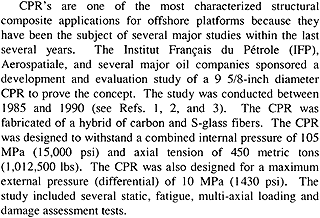OTC 11008
Mechanical Performance of Composite Production Risers
Douglas B. Johnson, P.E., Esq., Lincoln Composites; Donald D. Baldwin, Lincoln Composites; and, J. Randy Long, P.E., Stress Engineering Services, Inc.
Copyright 1999, Offshore Technology Conference
This paper was prepared for presentation at the 1999 Offshore Technology Conference held in Houston, Texas, 3-6 May 1999.
This paper was selected for presentation by the OTC Program Committee following review of information contained in an abstract submitted by the author(s). Contents of the paper, as presented, have not been reviewed by the Offshore Technology Conference and are subject to correction by the author(s). The material, as presented, does not necessarily reflect any position of the Offshore Technology Conference or its officers. Electronic reproduction, distribution, or storage of any part of this paper for commercial purposes without the written consent of the Offshore Technology Conference is prohibited. Permission to reproduce in print is restricted to an abstract of not more than 300 words; illustrations may not be copied. The abstract must contain conspicuous acknowledgment of where and by whom the paper was presented.
Abstract
In 1995, a joint effort was begun, under the auspices of the NIST ATP, to design, develop and test a composite production riser (CPR) suitable for deep water (3000 to 5000 feet) applications. The objective of the effort is to arrive at a cost-effective design for a composite production riser that meets reliability performance of current metal systems.
An integrated CPR design meeting the project cost, weight and performance goals was developed. A test program was defined to derive statistically sufficient data on mechanical properties and to identify failure modes and locations to achieve the required confidence in design, fabrication, and short and long term performance of the CPR. A total of 80 prototypes were fabricated and tested for ultimate strength determination, static and cyclic fatigue performance, and characterization of damage tolerance. A primary purpose of this testing was to correlate and analyze riser joint actual performance with predicted values, in the interest of verifying static and cyclic performance and manufacture variability. The final results of this testing and analysis are presented in this paper.
Introduction
As competition for oil increases, oil companies are drilling in deeper waters. Current deepwater oil completion and production technology utilizes steel riser systems that are heavy, require expensive tensioning and buoyancy systems. and whose designs are often governed by fatigue considerations. Composite risers would provide advantages over conventional steel risers because composite materials are (1) lighter weight, (2) more fatigue resistant, (3) more corrosion resistant, (4) can be designed for improved structural and mechanical response, and (5) are better thermal insulators. Overall, production platform cost reductions are possible as a result of the lower weight and greater compliance of composite risers, along with improvements in system reliability.
A CPR has the potential of reducing capital expenditure, mainly because their light weight will give rise to lower riser top tension (and hence lower loads supported by the platform). In addition, the more compliant CPR could help to reduce or eliminate the need for the top tensioning system, resulting in further cost benefits to the riser system and platform construction.
Background

As a follow-up to this study, Lincoln Composites (formerly Brunswick Composites), Coflexip, IFP and Aerospatiale proposed a joint industry project to reduce the cost of the CPR by optimizing the design and manufacturing process in 1993. The proposed design optimization included simplifying the metallic threaded joint, and using lower cost E-glass fiber for hoop reinforcement, instead of S-glass fiber. The goal of these proposed modifications was to reduce the cost of a 10 3/4-inch CPR from more than three (3) times the cost of a steel riser to less than two (2). Although the initial procurement cost of a CPR would still be higher than a steel riser, the total riser system cost would be reduced due to reduction in payload and tensioner costs. Although industry was unable to support the project at that time, the proposal became the basis for the current project.